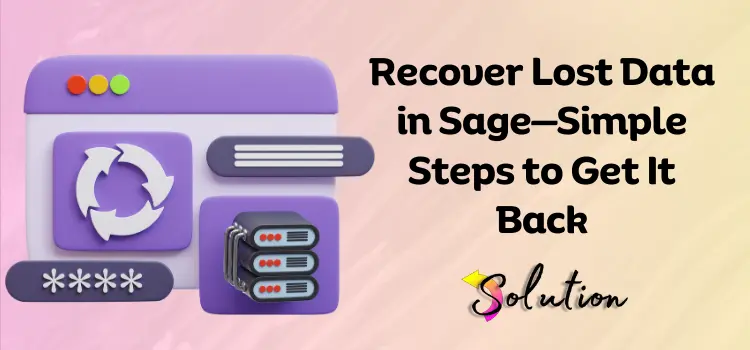
It can be annoying and overwhelming to lose important data in Sage, especially if it’s important financial or accounting records. Losing data can mess up your work and cause extra stress, whether it’s because you deleted something by accident, your software crashed, or there was a problem with the system. You might have destroyed a file because you thought you didn’t need it anymore, but then you found out that it was very important. Feels like you messed up right!
Don’t worry; here is good news: there are ways to get back lost data in Sage, and if you follow the right steps, you can get your data back quickly. Following a structured method is the key to getting your data back. You can easily get back lost data if you use the right backup files, Sage’s built-in recovery choices, and professional recovery tools. There are other ways to get back to your lost records that might work even if you don’t have a copy.
This guide will show you how to get back your lost Sage data. What you have to do is scroll down, read the steps, carefully follow them, and learn the process to avoid problems in the future. If you know what to do, you can quickly get back the data you lost and make sure your Sage accounting system works well again.
Common Mistakes That Lead to Data Loss in Sage— Avoid These Errors
Sage data loss can happen for many reasons, which is very bad for businesses. Problems can happen if you lose important financial or accounting info. Here are the most common reasons why Sage users lose info. Let’s take a look.
- Deletion by Accident: One major reason for data loss is mistakes made by people. Without proper backups, users may delete important files or overwrite important data by mistake, making recovery hard.
- Worn-out Data Files: Software crashes, incorrect computer shutdowns, or unexpected power outages can damage Sage data files. Damage can render these files unreadable or incomplete.
- Failure of Hardware: If your hard drive crashes, your server goes down, or your storage device stops working properly, you could lose your Sage information. It can be hard to get this information back if you don’t have a solid backup.
- Threats from Malware and Viruses: Ransomware and viruses are two types of cyber risks that can get into Sage systems and encrypt, damage, or delete data. For safety, it’s important to use strong antivirus software.
- Problems with Software and Updates: Software changes that don’t work with Sage or third-party apps can make the system unstable, which can lead to data loss or corruption. Make sure to make the right changes and perform compatibility checks to avoid such problems.
Easy and Effective Ways to Get Back Your Lost Sage Data
Sage gives you a number of options for getting back lost data, so it’s easy to get back important files. There is a solution for every problem, whether you want to use a recovery tool, send a data recovery request, or look into other choices. Here are the best ways to get better. Read through them and pick the one that works best for you.
Method 1: Launch the Sage Recovery Tool
Sage has a built-in recovery tool that can quickly get back lost or damaged files if you need advanced data recovery. The Sage Data Repair Utility can help you get back important files that you lost because of system problems, crashes, or corruption. This powerful tool makes sure that there is little downtime, so you can quickly restore your info and keep working without any problems.
- Open the Sage Data Repair Tool in your Sage program to begin the process.
- Now, click on the Data File that you want to get back.
- To start, click the Repair tab.
- Now, the tool will start looking for the mistake on its own and try to fix any damaged files it finds.
Method 2: Check the Backup Files Again
Checking to see if you have a backup is one of the best ways to get back Sage info that you’ve lost. Sage strongly advises making regular backups to keep data safe and make sure it can be recovered quickly. You can easily get back lost info in just a few steps if you have a recent backup saved somewhere safe.
- Start by opening the Sage app on your phone or tablet.
- Pick up the File tab and click on the Restore button.
- Then, pick the Browser and click on the backup file you want to recover.
- Then, finish the restoration process by following the on-screen directions.
- You can get your info back from both local and cloud-based backups with Sage. (Make sure the backup you use is up-to-date to avoid losing too much info.)
Method 3: Use the SQL Database
You may be able to get back lost data in a different way if you use Sage 100, Sage 300, or any other Sage system that uses SQL databases. Since Sage saves data in SQL databases, you can use SQL commands or special software to try to get back records that are missing or damaged.
- Open the SQL Server Management Studio (SSMS) on your computer or phone first.
- Now, connect to the instance of SQL Server that holds your Sage database.
- Keep running a query to see if any data is missing or if there are recovery points.
- Use the Database Restore methods to get back data or versions of the database that were saved in the past.
Method 4: Bring Back the Company File for Single Payroll
Restoring a single company file is another good way to get back lost data in Sage 50 Payroll. You can get back to work with your system and get important salary information by following this process.
- Open Sage Payroll and log in to the chosen payroll that you used to get back the company file.
- Now, go to the menu bar and click on Other.
- After finishing, click on Restore and open your browser.
- Here, you need to find the folder that has the company file.
- To see the details, click the OK tab and then the Show Details button.
- Now you have to look at the details of information that can be restored and make sure it is correct.
- If they are wrong, open the browser again with the right one.
- To have Direct Payroll Reporting with a registration log, the payroll filing information, and RPN retrieval.
- Pick the recovery method you need.
- Check the box that says Restore Direct Reposting Data, and then make sure that it overwrites the earlier submission of the EPN and ROS log documents for payroll.
- Overwrite a company or group file that already exists.
- Next, make a new company with the restored data or a new company where you had to make a choice about which backup you wanted to make. Keep in mind that this process will not delete the current data.
- Choose the option you need by clicking on the Next tab and reading through the list of options below:
- Changed forms
- Comes with business and data reports
- Information about an organization
- After that, click the Next tab and pick one of the options that are already there.
- Once the setup is complete, click the Finish button to restart the business.
- The process is over when you click on the Restore button.
Method 5: Make data recovery software work better
Don’t worry if none of the above methods worked to get back your lost Sage data. There’s still hope! You can get back your lost files with third-party data recovery tools. These tools can retrieve data from damaged or lost hard drives, providing you with an additional opportunity to retrieve your crucial files. Even though Sage’s built-in recovery choices work well, external recovery solutions can be useful in case everything else fails. Make sure you pick a repair tool with a good reputation and carefully follow the steps. If you take the right steps, you can get back your lost info and keep working without stopping!
Conclusion!
Always make regular backups of your Sage data and store them safely on hard drives or in the cloud to avoid losing it. Use Sage’s built-in recovery tools and keep your system up to date to make a strong data recovery plan. Check files twice before you delete them to avoid losing them by accident. Also, make sure you have good security software to keep malware that can damage your data at bay. If you do lose data, you need to move quickly and follow the right steps to get it back. By taking these proactive steps, you can protect your important financial info and reduce the number of problems that happen in the future. If you stay ready, you’ll never have to worry about losing info again!


